Network Management: Importance, Protocols, and Standards
VerifiedAdded on 2021/07/28
|21
|6547
|307
Report
AI Summary
This report meticulously evaluates the critical importance of network management in maintaining efficient and secure IT environments. It emphasizes the necessity of regular network maintenance to prevent productivity setbacks and downtime, highlighting threat detection, virus prevention, and the achievement of maximum efficiency through system updates. The report explores various network protocols and standards, including SNMP, NETCONF, RMON, TCP/IP, HTTP, DNS, DHCP, SSL, IPSec, IEEE, ITU, ISO, OSI, IANA, and ICANN, detailing their functions and significance in modern digital communications. It further examines the practical applications of network management in areas such as business lead generation, identification of best practices, and adaptation to new business trends. The report also underscores the financial benefits of professional network management, the potential for accelerated business growth, and the advantages of proactively managed networks, thereby providing a comprehensive overview of network management's vital role in today's technological landscape. This assignment is available on Desklib, a platform offering AI-based study tools for students.
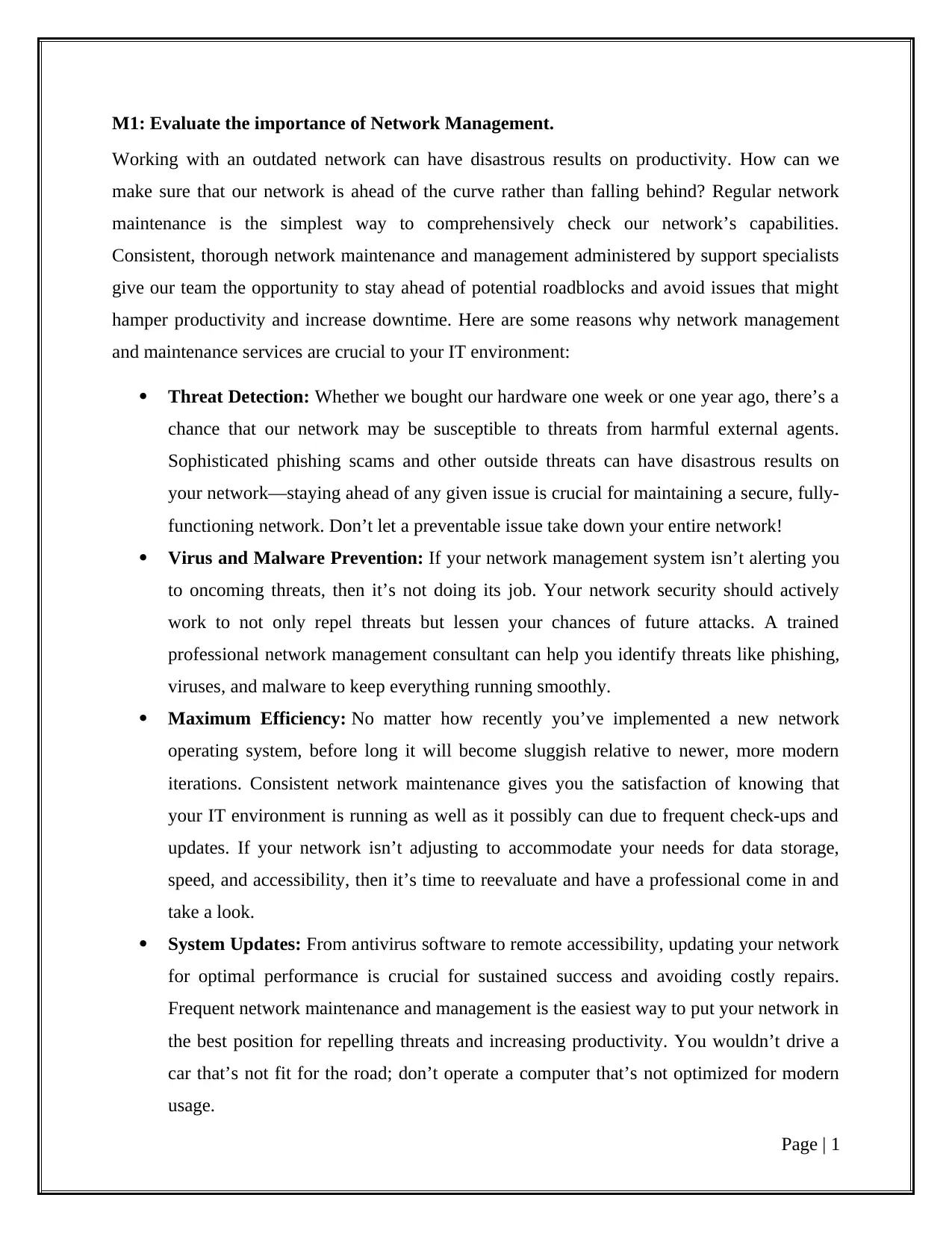
M1: Evaluate the importance of Network Management.
Working with an outdated network can have disastrous results on productivity. How can we
make sure that our network is ahead of the curve rather than falling behind? Regular network
maintenance is the simplest way to comprehensively check our network’s capabilities.
Consistent, thorough network maintenance and management administered by support specialists
give our team the opportunity to stay ahead of potential roadblocks and avoid issues that might
hamper productivity and increase downtime. Here are some reasons why network management
and maintenance services are crucial to your IT environment:
Threat Detection: Whether we bought our hardware one week or one year ago, there’s a
chance that our network may be susceptible to threats from harmful external agents.
Sophisticated phishing scams and other outside threats can have disastrous results on
your network—staying ahead of any given issue is crucial for maintaining a secure, fully-
functioning network. Don’t let a preventable issue take down your entire network!
Virus and Malware Prevention: If your network management system isn’t alerting you
to oncoming threats, then it’s not doing its job. Your network security should actively
work to not only repel threats but lessen your chances of future attacks. A trained
professional network management consultant can help you identify threats like phishing,
viruses, and malware to keep everything running smoothly.
Maximum Efficiency: No matter how recently you’ve implemented a new network
operating system, before long it will become sluggish relative to newer, more modern
iterations. Consistent network maintenance gives you the satisfaction of knowing that
your IT environment is running as well as it possibly can due to frequent check-ups and
updates. If your network isn’t adjusting to accommodate your needs for data storage,
speed, and accessibility, then it’s time to reevaluate and have a professional come in and
take a look.
System Updates: From antivirus software to remote accessibility, updating your network
for optimal performance is crucial for sustained success and avoiding costly repairs.
Frequent network maintenance and management is the easiest way to put your network in
the best position for repelling threats and increasing productivity. You wouldn’t drive a
car that’s not fit for the road; don’t operate a computer that’s not optimized for modern
usage.
Page | 1
Working with an outdated network can have disastrous results on productivity. How can we
make sure that our network is ahead of the curve rather than falling behind? Regular network
maintenance is the simplest way to comprehensively check our network’s capabilities.
Consistent, thorough network maintenance and management administered by support specialists
give our team the opportunity to stay ahead of potential roadblocks and avoid issues that might
hamper productivity and increase downtime. Here are some reasons why network management
and maintenance services are crucial to your IT environment:
Threat Detection: Whether we bought our hardware one week or one year ago, there’s a
chance that our network may be susceptible to threats from harmful external agents.
Sophisticated phishing scams and other outside threats can have disastrous results on
your network—staying ahead of any given issue is crucial for maintaining a secure, fully-
functioning network. Don’t let a preventable issue take down your entire network!
Virus and Malware Prevention: If your network management system isn’t alerting you
to oncoming threats, then it’s not doing its job. Your network security should actively
work to not only repel threats but lessen your chances of future attacks. A trained
professional network management consultant can help you identify threats like phishing,
viruses, and malware to keep everything running smoothly.
Maximum Efficiency: No matter how recently you’ve implemented a new network
operating system, before long it will become sluggish relative to newer, more modern
iterations. Consistent network maintenance gives you the satisfaction of knowing that
your IT environment is running as well as it possibly can due to frequent check-ups and
updates. If your network isn’t adjusting to accommodate your needs for data storage,
speed, and accessibility, then it’s time to reevaluate and have a professional come in and
take a look.
System Updates: From antivirus software to remote accessibility, updating your network
for optimal performance is crucial for sustained success and avoiding costly repairs.
Frequent network maintenance and management is the easiest way to put your network in
the best position for repelling threats and increasing productivity. You wouldn’t drive a
car that’s not fit for the road; don’t operate a computer that’s not optimized for modern
usage.
Page | 1
Paraphrase This Document
Need a fresh take? Get an instant paraphrase of this document with our AI Paraphraser
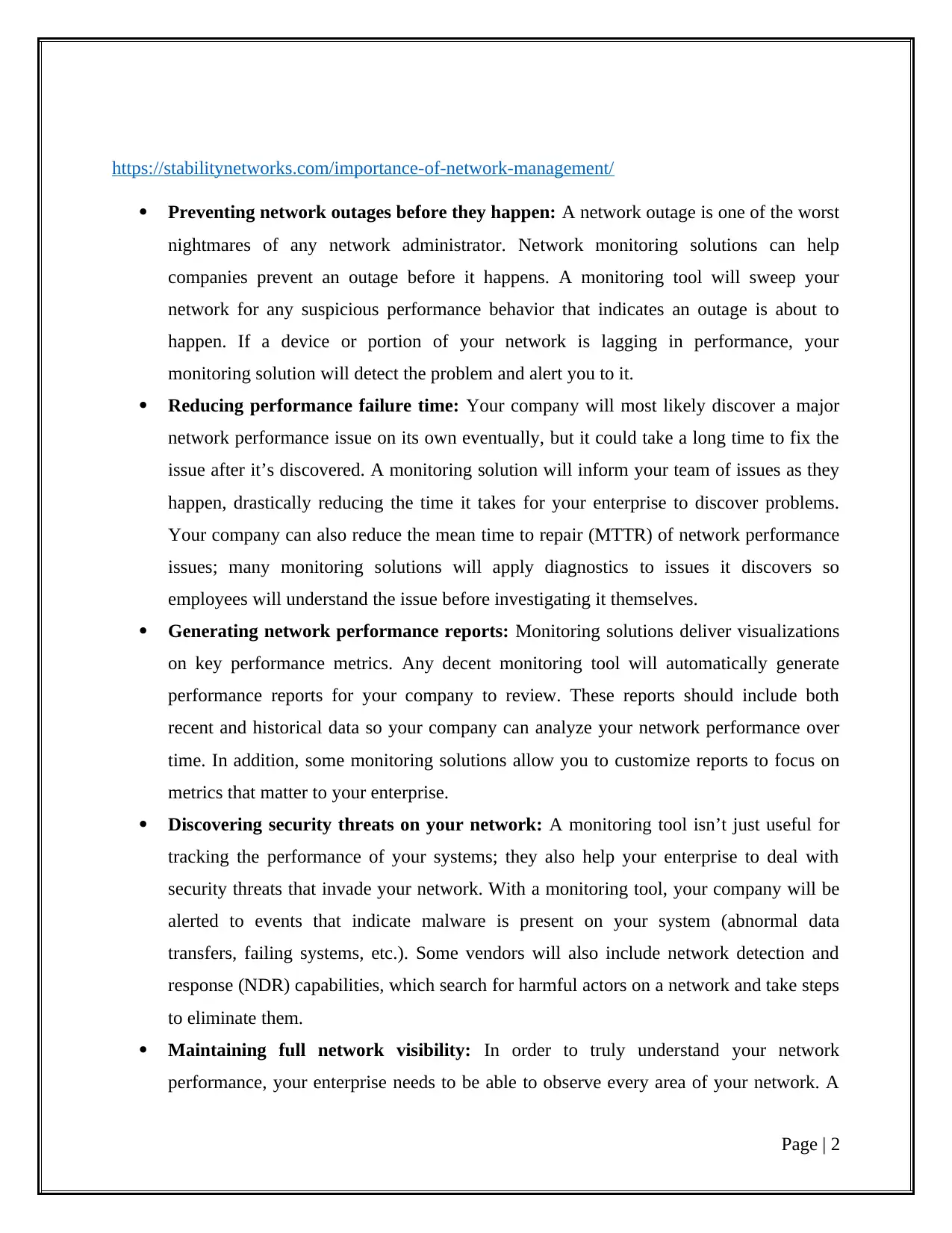
https://stabilitynetworks.com/importance-of-network-management/
Preventing network outages before they happen: A network outage is one of the worst
nightmares of any network administrator. Network monitoring solutions can help
companies prevent an outage before it happens. A monitoring tool will sweep your
network for any suspicious performance behavior that indicates an outage is about to
happen. If a device or portion of your network is lagging in performance, your
monitoring solution will detect the problem and alert you to it.
Reducing performance failure time: Your company will most likely discover a major
network performance issue on its own eventually, but it could take a long time to fix the
issue after it’s discovered. A monitoring solution will inform your team of issues as they
happen, drastically reducing the time it takes for your enterprise to discover problems.
Your company can also reduce the mean time to repair (MTTR) of network performance
issues; many monitoring solutions will apply diagnostics to issues it discovers so
employees will understand the issue before investigating it themselves.
Generating network performance reports: Monitoring solutions deliver visualizations
on key performance metrics. Any decent monitoring tool will automatically generate
performance reports for your company to review. These reports should include both
recent and historical data so your company can analyze your network performance over
time. In addition, some monitoring solutions allow you to customize reports to focus on
metrics that matter to your enterprise.
Discovering security threats on your network: A monitoring tool isn’t just useful for
tracking the performance of your systems; they also help your enterprise to deal with
security threats that invade your network. With a monitoring tool, your company will be
alerted to events that indicate malware is present on your system (abnormal data
transfers, failing systems, etc.). Some vendors will also include network detection and
response (NDR) capabilities, which search for harmful actors on a network and take steps
to eliminate them.
Maintaining full network visibility: In order to truly understand your network
performance, your enterprise needs to be able to observe every area of your network. A
Page | 2
Preventing network outages before they happen: A network outage is one of the worst
nightmares of any network administrator. Network monitoring solutions can help
companies prevent an outage before it happens. A monitoring tool will sweep your
network for any suspicious performance behavior that indicates an outage is about to
happen. If a device or portion of your network is lagging in performance, your
monitoring solution will detect the problem and alert you to it.
Reducing performance failure time: Your company will most likely discover a major
network performance issue on its own eventually, but it could take a long time to fix the
issue after it’s discovered. A monitoring solution will inform your team of issues as they
happen, drastically reducing the time it takes for your enterprise to discover problems.
Your company can also reduce the mean time to repair (MTTR) of network performance
issues; many monitoring solutions will apply diagnostics to issues it discovers so
employees will understand the issue before investigating it themselves.
Generating network performance reports: Monitoring solutions deliver visualizations
on key performance metrics. Any decent monitoring tool will automatically generate
performance reports for your company to review. These reports should include both
recent and historical data so your company can analyze your network performance over
time. In addition, some monitoring solutions allow you to customize reports to focus on
metrics that matter to your enterprise.
Discovering security threats on your network: A monitoring tool isn’t just useful for
tracking the performance of your systems; they also help your enterprise to deal with
security threats that invade your network. With a monitoring tool, your company will be
alerted to events that indicate malware is present on your system (abnormal data
transfers, failing systems, etc.). Some vendors will also include network detection and
response (NDR) capabilities, which search for harmful actors on a network and take steps
to eliminate them.
Maintaining full network visibility: In order to truly understand your network
performance, your enterprise needs to be able to observe every area of your network. A
Page | 2

portion of a network that your business can’t monitor could be causing performance
issues that might affect your entire system. Monitoring solutions automatically detect
devices that connect to a network, drawing and updating visual maps that display insights
into the performance of your network nodes.
https://solutionsreview.com/network-monitoring/why-is-network-monitoring-important-for-
enterprises/
Business Leads: Managing a network is an excellent approach to acquire new business
leads. Using the contacts, you can get in touch with your clients to open doors for new
business opportunities. Connect professionally when you follow up on leads, as SMBs
and enterprises level businesses always look for outsourcing companies to manage their
network. Always be on time and use common courtesy while following up with your
contacts.
Identify Best Practices: Network monitoring is the best way to determine the best
practices or industry benchmark for business. Learning from what others do is a
significant strategy for your company. Network management services ensure that your IT
infrastructure management tools and devices work smoothly. Monitoring helps you to
recognize the existence and changes within your organization’s IT. It also assists you to
define the importance of latest technologies for your business.
New Business Trends: Networking can help you stay ahead in this competitive era of
advancing technology and new business trends in your industry. These relationships and
“inside” information can add advantage to your business over your competitors by
applying new and fresh methods of doing things. It also allows businesses to generate
new leads, whether it is a new partner for future project or a new customer.
Save Money: A professional network team can save you lots of money with their
expertise, knowledge and resourceful network management skills. They keep themselves
up-to-date with the latest technological trends of network industry that can create
opportunities for you. By being proactively associated with your IT infrastructure, you
can be sure that you will encounter less downtime and achieve enhanced productivity.
Accelerated Growth: Services provided by a network solution provider can help your
business become poised for an increased growth. With a tailored, scalable, and reliable
network services in place, your organization will be able to acknowledge possibilities for
Page | 3
issues that might affect your entire system. Monitoring solutions automatically detect
devices that connect to a network, drawing and updating visual maps that display insights
into the performance of your network nodes.
https://solutionsreview.com/network-monitoring/why-is-network-monitoring-important-for-
enterprises/
Business Leads: Managing a network is an excellent approach to acquire new business
leads. Using the contacts, you can get in touch with your clients to open doors for new
business opportunities. Connect professionally when you follow up on leads, as SMBs
and enterprises level businesses always look for outsourcing companies to manage their
network. Always be on time and use common courtesy while following up with your
contacts.
Identify Best Practices: Network monitoring is the best way to determine the best
practices or industry benchmark for business. Learning from what others do is a
significant strategy for your company. Network management services ensure that your IT
infrastructure management tools and devices work smoothly. Monitoring helps you to
recognize the existence and changes within your organization’s IT. It also assists you to
define the importance of latest technologies for your business.
New Business Trends: Networking can help you stay ahead in this competitive era of
advancing technology and new business trends in your industry. These relationships and
“inside” information can add advantage to your business over your competitors by
applying new and fresh methods of doing things. It also allows businesses to generate
new leads, whether it is a new partner for future project or a new customer.
Save Money: A professional network team can save you lots of money with their
expertise, knowledge and resourceful network management skills. They keep themselves
up-to-date with the latest technological trends of network industry that can create
opportunities for you. By being proactively associated with your IT infrastructure, you
can be sure that you will encounter less downtime and achieve enhanced productivity.
Accelerated Growth: Services provided by a network solution provider can help your
business become poised for an increased growth. With a tailored, scalable, and reliable
network services in place, your organization will be able to acknowledge possibilities for
Page | 3
⊘ This is a preview!⊘
Do you want full access?
Subscribe today to unlock all pages.

Trusted by 1+ million students worldwide
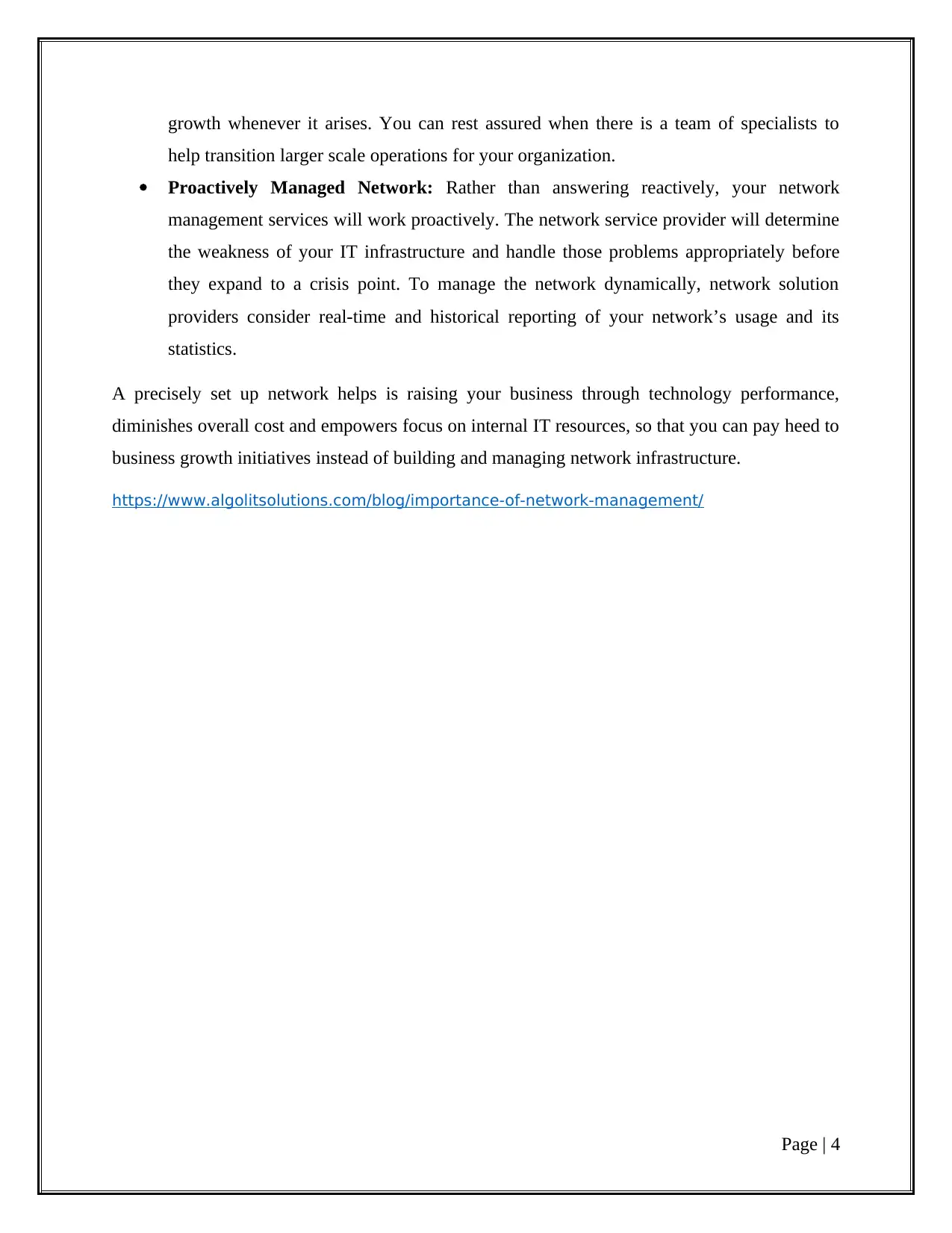
growth whenever it arises. You can rest assured when there is a team of specialists to
help transition larger scale operations for your organization.
Proactively Managed Network: Rather than answering reactively, your network
management services will work proactively. The network service provider will determine
the weakness of your IT infrastructure and handle those problems appropriately before
they expand to a crisis point. To manage the network dynamically, network solution
providers consider real-time and historical reporting of your network’s usage and its
statistics.
A precisely set up network helps is raising your business through technology performance,
diminishes overall cost and empowers focus on internal IT resources, so that you can pay heed to
business growth initiatives instead of building and managing network infrastructure.
https://www.algolitsolutions.com/blog/importance-of-network-management/
Page | 4
help transition larger scale operations for your organization.
Proactively Managed Network: Rather than answering reactively, your network
management services will work proactively. The network service provider will determine
the weakness of your IT infrastructure and handle those problems appropriately before
they expand to a crisis point. To manage the network dynamically, network solution
providers consider real-time and historical reporting of your network’s usage and its
statistics.
A precisely set up network helps is raising your business through technology performance,
diminishes overall cost and empowers focus on internal IT resources, so that you can pay heed to
business growth initiatives instead of building and managing network infrastructure.
https://www.algolitsolutions.com/blog/importance-of-network-management/
Page | 4
Paraphrase This Document
Need a fresh take? Get an instant paraphrase of this document with our AI Paraphraser
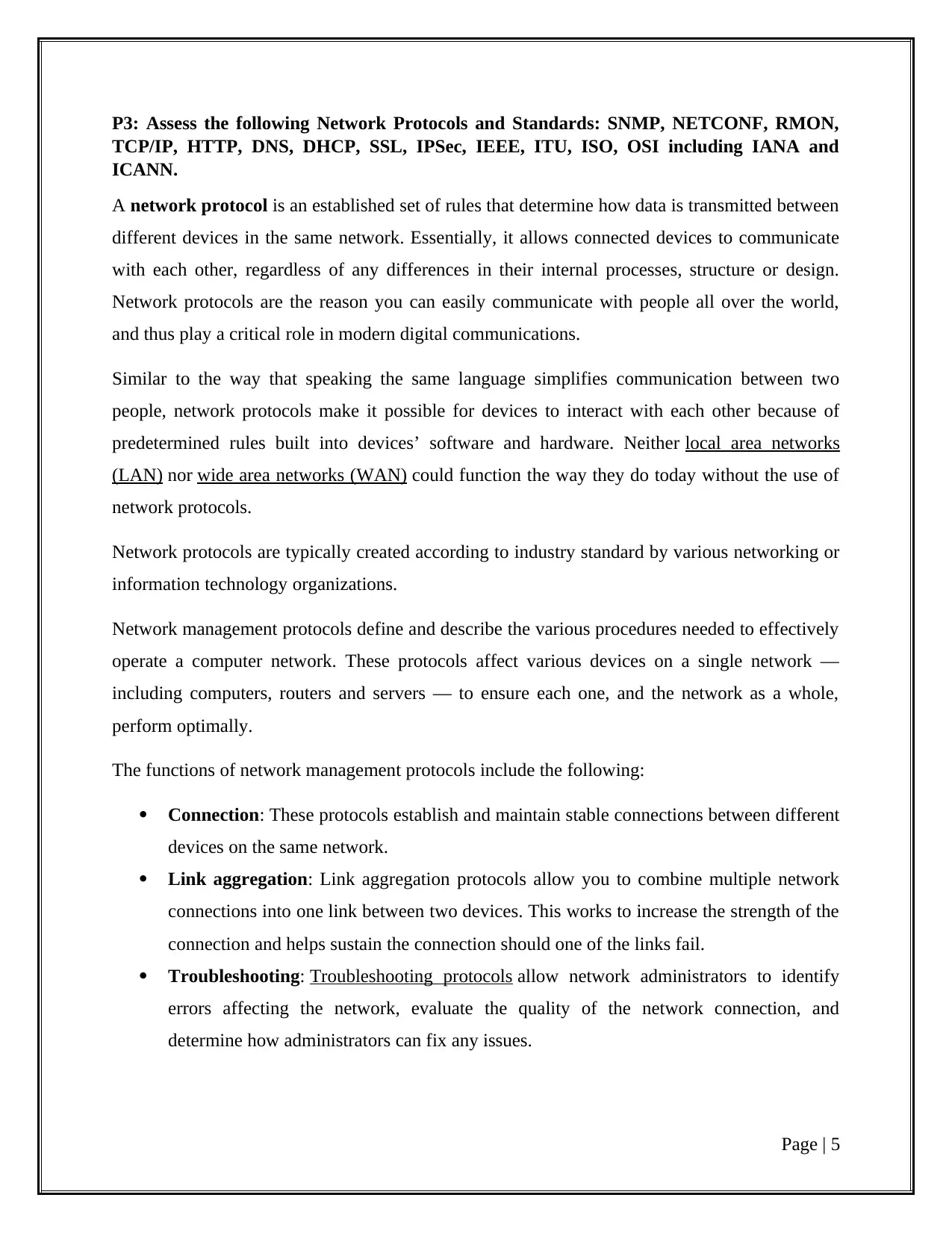
P3: Assess the following Network Protocols and Standards: SNMP, NETCONF, RMON,
TCP/IP, HTTP, DNS, DHCP, SSL, IPSec, IEEE, ITU, ISO, OSI including IANA and
ICANN.
A network protocol is an established set of rules that determine how data is transmitted between
different devices in the same network. Essentially, it allows connected devices to communicate
with each other, regardless of any differences in their internal processes, structure or design.
Network protocols are the reason you can easily communicate with people all over the world,
and thus play a critical role in modern digital communications.
Similar to the way that speaking the same language simplifies communication between two
people, network protocols make it possible for devices to interact with each other because of
predetermined rules built into devices’ software and hardware. Neither local area networks
(LAN) nor wide area networks (WAN) could function the way they do today without the use of
network protocols.
Network protocols are typically created according to industry standard by various networking or
information technology organizations.
Network management protocols define and describe the various procedures needed to effectively
operate a computer network. These protocols affect various devices on a single network —
including computers, routers and servers — to ensure each one, and the network as a whole,
perform optimally.
The functions of network management protocols include the following:
Connection: These protocols establish and maintain stable connections between different
devices on the same network.
Link aggregation: Link aggregation protocols allow you to combine multiple network
connections into one link between two devices. This works to increase the strength of the
connection and helps sustain the connection should one of the links fail.
Troubleshooting: Troubleshooting protocols allow network administrators to identify
errors affecting the network, evaluate the quality of the network connection, and
determine how administrators can fix any issues.
Page | 5
TCP/IP, HTTP, DNS, DHCP, SSL, IPSec, IEEE, ITU, ISO, OSI including IANA and
ICANN.
A network protocol is an established set of rules that determine how data is transmitted between
different devices in the same network. Essentially, it allows connected devices to communicate
with each other, regardless of any differences in their internal processes, structure or design.
Network protocols are the reason you can easily communicate with people all over the world,
and thus play a critical role in modern digital communications.
Similar to the way that speaking the same language simplifies communication between two
people, network protocols make it possible for devices to interact with each other because of
predetermined rules built into devices’ software and hardware. Neither local area networks
(LAN) nor wide area networks (WAN) could function the way they do today without the use of
network protocols.
Network protocols are typically created according to industry standard by various networking or
information technology organizations.
Network management protocols define and describe the various procedures needed to effectively
operate a computer network. These protocols affect various devices on a single network —
including computers, routers and servers — to ensure each one, and the network as a whole,
perform optimally.
The functions of network management protocols include the following:
Connection: These protocols establish and maintain stable connections between different
devices on the same network.
Link aggregation: Link aggregation protocols allow you to combine multiple network
connections into one link between two devices. This works to increase the strength of the
connection and helps sustain the connection should one of the links fail.
Troubleshooting: Troubleshooting protocols allow network administrators to identify
errors affecting the network, evaluate the quality of the network connection, and
determine how administrators can fix any issues.
Page | 5

Use of Network protocol:
Network protocols aren’t only relevant to certified network specialists or IT professionals.
Billions of people use network protocols daily, whether they know it or not. Every time you use
the internet, you leverage network protocols. Though you may not know how network protocols
work or how frequently you encounter them, they are necessary for using the internet or digital
communications in any capacity. https://www.comptia.org/content/guides/what-is-a-network-
protocol
Network Protocols:
SNMP: SNMP (Simple Network Management Protocol) is an application layer protocol used
to manage nodes, like servers, workstations, routers, switches, etc., on an IP network. SNMP
enables network admins to monitor network performance, identify network glitches, and
troubleshoot them. SNMP protocol is comprised of three components: a managed device, an
SNMP agent, and an SNMP manager. Currently, there are three versions of SNMP: SNMP
v1, SNMP v2, and SNMP v3. Both versions 1 and 2 have many features in common, but
SNMP v2 offers enhancements such as additional protocol operations. SNMP version 3
(SNMP v3) adds security and remote configuration capabilities to the previous versions.
NETCONF: Network Configuration Protocol (NETCONF) is a standard transport protocol
that communicates with network devices. NETCONF provides mechanisms to edit
configuration data and retrieve operational data from network devices. The configuration
data represents the way interfaces, routing protocols and other network features are
provisioned. The operational data represents the interface statistics, memory utilization,
errors, and so on. NETCONF uses an Extensible Markup Language (XML)-based data
encoding for the configuration data, as well as protocol messages. It uses a simple RPC-
based (Remote Procedure Call) mechanism to facilitate communication between a client and
a server. The client can be a script or application that runs as part of a network manager. The
server is a network device such as a router. NETCONF defines how to communicate with the
devices, but does not handle what data is exchanged between the client and the server.
Page | 6
Network protocols aren’t only relevant to certified network specialists or IT professionals.
Billions of people use network protocols daily, whether they know it or not. Every time you use
the internet, you leverage network protocols. Though you may not know how network protocols
work or how frequently you encounter them, they are necessary for using the internet or digital
communications in any capacity. https://www.comptia.org/content/guides/what-is-a-network-
protocol
Network Protocols:
SNMP: SNMP (Simple Network Management Protocol) is an application layer protocol used
to manage nodes, like servers, workstations, routers, switches, etc., on an IP network. SNMP
enables network admins to monitor network performance, identify network glitches, and
troubleshoot them. SNMP protocol is comprised of three components: a managed device, an
SNMP agent, and an SNMP manager. Currently, there are three versions of SNMP: SNMP
v1, SNMP v2, and SNMP v3. Both versions 1 and 2 have many features in common, but
SNMP v2 offers enhancements such as additional protocol operations. SNMP version 3
(SNMP v3) adds security and remote configuration capabilities to the previous versions.
NETCONF: Network Configuration Protocol (NETCONF) is a standard transport protocol
that communicates with network devices. NETCONF provides mechanisms to edit
configuration data and retrieve operational data from network devices. The configuration
data represents the way interfaces, routing protocols and other network features are
provisioned. The operational data represents the interface statistics, memory utilization,
errors, and so on. NETCONF uses an Extensible Markup Language (XML)-based data
encoding for the configuration data, as well as protocol messages. It uses a simple RPC-
based (Remote Procedure Call) mechanism to facilitate communication between a client and
a server. The client can be a script or application that runs as part of a network manager. The
server is a network device such as a router. NETCONF defines how to communicate with the
devices, but does not handle what data is exchanged between the client and the server.
Page | 6
⊘ This is a preview!⊘
Do you want full access?
Subscribe today to unlock all pages.

Trusted by 1+ million students worldwide
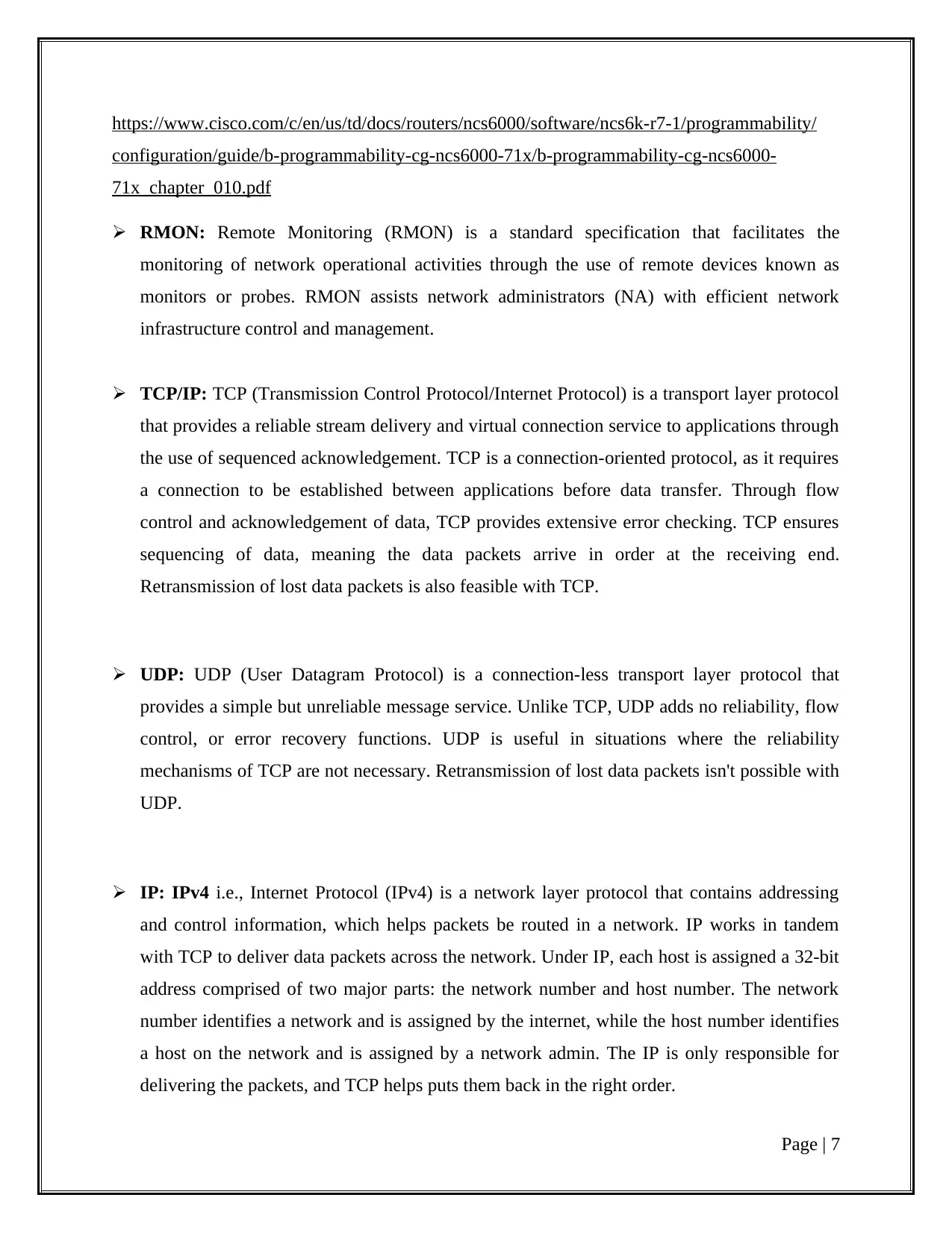
https://www.cisco.com/c/en/us/td/docs/routers/ncs6000/software/ncs6k-r7-1/programmability/
configuration/guide/b-programmability-cg-ncs6000-71x/b-programmability-cg-ncs6000-
71x_chapter_010.pdf
RMON: Remote Monitoring (RMON) is a standard specification that facilitates the
monitoring of network operational activities through the use of remote devices known as
monitors or probes. RMON assists network administrators (NA) with efficient network
infrastructure control and management.
TCP/IP: TCP (Transmission Control Protocol/Internet Protocol) is a transport layer protocol
that provides a reliable stream delivery and virtual connection service to applications through
the use of sequenced acknowledgement. TCP is a connection-oriented protocol, as it requires
a connection to be established between applications before data transfer. Through flow
control and acknowledgement of data, TCP provides extensive error checking. TCP ensures
sequencing of data, meaning the data packets arrive in order at the receiving end.
Retransmission of lost data packets is also feasible with TCP.
UDP: UDP (User Datagram Protocol) is a connection-less transport layer protocol that
provides a simple but unreliable message service. Unlike TCP, UDP adds no reliability, flow
control, or error recovery functions. UDP is useful in situations where the reliability
mechanisms of TCP are not necessary. Retransmission of lost data packets isn't possible with
UDP.
IP: IPv4 i.e., Internet Protocol (IPv4) is a network layer protocol that contains addressing
and control information, which helps packets be routed in a network. IP works in tandem
with TCP to deliver data packets across the network. Under IP, each host is assigned a 32-bit
address comprised of two major parts: the network number and host number. The network
number identifies a network and is assigned by the internet, while the host number identifies
a host on the network and is assigned by a network admin. The IP is only responsible for
delivering the packets, and TCP helps puts them back in the right order.
Page | 7
configuration/guide/b-programmability-cg-ncs6000-71x/b-programmability-cg-ncs6000-
71x_chapter_010.pdf
RMON: Remote Monitoring (RMON) is a standard specification that facilitates the
monitoring of network operational activities through the use of remote devices known as
monitors or probes. RMON assists network administrators (NA) with efficient network
infrastructure control and management.
TCP/IP: TCP (Transmission Control Protocol/Internet Protocol) is a transport layer protocol
that provides a reliable stream delivery and virtual connection service to applications through
the use of sequenced acknowledgement. TCP is a connection-oriented protocol, as it requires
a connection to be established between applications before data transfer. Through flow
control and acknowledgement of data, TCP provides extensive error checking. TCP ensures
sequencing of data, meaning the data packets arrive in order at the receiving end.
Retransmission of lost data packets is also feasible with TCP.
UDP: UDP (User Datagram Protocol) is a connection-less transport layer protocol that
provides a simple but unreliable message service. Unlike TCP, UDP adds no reliability, flow
control, or error recovery functions. UDP is useful in situations where the reliability
mechanisms of TCP are not necessary. Retransmission of lost data packets isn't possible with
UDP.
IP: IPv4 i.e., Internet Protocol (IPv4) is a network layer protocol that contains addressing
and control information, which helps packets be routed in a network. IP works in tandem
with TCP to deliver data packets across the network. Under IP, each host is assigned a 32-bit
address comprised of two major parts: the network number and host number. The network
number identifies a network and is assigned by the internet, while the host number identifies
a host on the network and is assigned by a network admin. The IP is only responsible for
delivering the packets, and TCP helps puts them back in the right order.
Page | 7
Paraphrase This Document
Need a fresh take? Get an instant paraphrase of this document with our AI Paraphraser
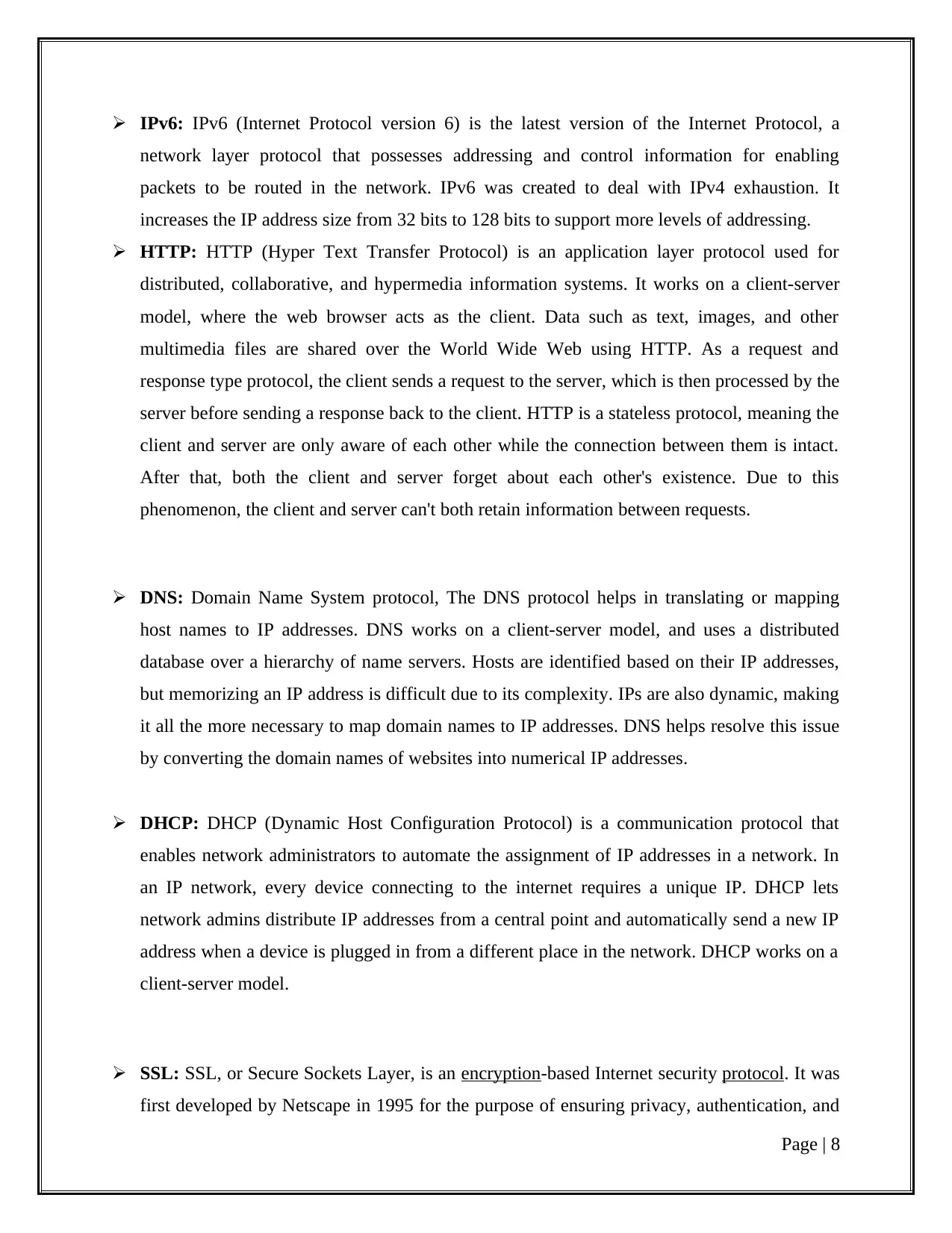
IPv6: IPv6 (Internet Protocol version 6) is the latest version of the Internet Protocol, a
network layer protocol that possesses addressing and control information for enabling
packets to be routed in the network. IPv6 was created to deal with IPv4 exhaustion. It
increases the IP address size from 32 bits to 128 bits to support more levels of addressing.
HTTP: HTTP (Hyper Text Transfer Protocol) is an application layer protocol used for
distributed, collaborative, and hypermedia information systems. It works on a client-server
model, where the web browser acts as the client. Data such as text, images, and other
multimedia files are shared over the World Wide Web using HTTP. As a request and
response type protocol, the client sends a request to the server, which is then processed by the
server before sending a response back to the client. HTTP is a stateless protocol, meaning the
client and server are only aware of each other while the connection between them is intact.
After that, both the client and server forget about each other's existence. Due to this
phenomenon, the client and server can't both retain information between requests.
DNS: Domain Name System protocol, The DNS protocol helps in translating or mapping
host names to IP addresses. DNS works on a client-server model, and uses a distributed
database over a hierarchy of name servers. Hosts are identified based on their IP addresses,
but memorizing an IP address is difficult due to its complexity. IPs are also dynamic, making
it all the more necessary to map domain names to IP addresses. DNS helps resolve this issue
by converting the domain names of websites into numerical IP addresses.
DHCP: DHCP (Dynamic Host Configuration Protocol) is a communication protocol that
enables network administrators to automate the assignment of IP addresses in a network. In
an IP network, every device connecting to the internet requires a unique IP. DHCP lets
network admins distribute IP addresses from a central point and automatically send a new IP
address when a device is plugged in from a different place in the network. DHCP works on a
client-server model.
SSL: SSL, or Secure Sockets Layer, is an encryption-based Internet security protocol. It was
first developed by Netscape in 1995 for the purpose of ensuring privacy, authentication, and
Page | 8
network layer protocol that possesses addressing and control information for enabling
packets to be routed in the network. IPv6 was created to deal with IPv4 exhaustion. It
increases the IP address size from 32 bits to 128 bits to support more levels of addressing.
HTTP: HTTP (Hyper Text Transfer Protocol) is an application layer protocol used for
distributed, collaborative, and hypermedia information systems. It works on a client-server
model, where the web browser acts as the client. Data such as text, images, and other
multimedia files are shared over the World Wide Web using HTTP. As a request and
response type protocol, the client sends a request to the server, which is then processed by the
server before sending a response back to the client. HTTP is a stateless protocol, meaning the
client and server are only aware of each other while the connection between them is intact.
After that, both the client and server forget about each other's existence. Due to this
phenomenon, the client and server can't both retain information between requests.
DNS: Domain Name System protocol, The DNS protocol helps in translating or mapping
host names to IP addresses. DNS works on a client-server model, and uses a distributed
database over a hierarchy of name servers. Hosts are identified based on their IP addresses,
but memorizing an IP address is difficult due to its complexity. IPs are also dynamic, making
it all the more necessary to map domain names to IP addresses. DNS helps resolve this issue
by converting the domain names of websites into numerical IP addresses.
DHCP: DHCP (Dynamic Host Configuration Protocol) is a communication protocol that
enables network administrators to automate the assignment of IP addresses in a network. In
an IP network, every device connecting to the internet requires a unique IP. DHCP lets
network admins distribute IP addresses from a central point and automatically send a new IP
address when a device is plugged in from a different place in the network. DHCP works on a
client-server model.
SSL: SSL, or Secure Sockets Layer, is an encryption-based Internet security protocol. It was
first developed by Netscape in 1995 for the purpose of ensuring privacy, authentication, and
Page | 8

data integrity in Internet communications. SSL is the predecessor to the
modern TLS encryption used today. A website that implements SSL/TLS has "HTTPS" in its
URL instead of "HTTP." https://www.cloudflare.com/learning/ssl/what-is-ssl/
IPsec: Internet Protocol Security (IPsec) sets up encrypted, authenticated IP connections over
a virtual private network (VPN). Technically IPsec is not a protocol, but rather a collection of
protocols that includes the Encapsulating Security Protocol (ESP), Authentication Header
(AH), and Security Associations (SA).
https://www.manageengine.com/network-monitoring/network-protocols.html
Network Standards:
Networking standards define the rules for data communications that are needed for
interoperability of networking technologies and processes. Standards help in creating and
maintaining open markets and allow different vendors to compete on the basis of the quality of
their products while being compatible with existing market products.
Types of Standards
De facto − These are the standards that are followed without any formal plan or approval
by any organization. They have come into existence due to traditions or facts. For
example, the HTTP had started as a de facto standard.
De jure − These standards are the ones which have been adopted through legislation by
any officially recognized standards organization. Most of the communication standards
that are used today are de jure standards. https://www.tutorialspoint.com/Network-
Standardization
Standards Organizations:
International Telecommunication Union (ITU)
The International Telecommunication Union (ITU) is made up of telecommunication policy
makers and regulators, network operators, equipment manufacturers, hardware and software
developers, regional standards-making organizations, and financing institutions. The activities,
policies, and strategic direction of the ITU are determined and shaped by the industry it serves.
Page | 9
modern TLS encryption used today. A website that implements SSL/TLS has "HTTPS" in its
URL instead of "HTTP." https://www.cloudflare.com/learning/ssl/what-is-ssl/
IPsec: Internet Protocol Security (IPsec) sets up encrypted, authenticated IP connections over
a virtual private network (VPN). Technically IPsec is not a protocol, but rather a collection of
protocols that includes the Encapsulating Security Protocol (ESP), Authentication Header
(AH), and Security Associations (SA).
https://www.manageengine.com/network-monitoring/network-protocols.html
Network Standards:
Networking standards define the rules for data communications that are needed for
interoperability of networking technologies and processes. Standards help in creating and
maintaining open markets and allow different vendors to compete on the basis of the quality of
their products while being compatible with existing market products.
Types of Standards
De facto − These are the standards that are followed without any formal plan or approval
by any organization. They have come into existence due to traditions or facts. For
example, the HTTP had started as a de facto standard.
De jure − These standards are the ones which have been adopted through legislation by
any officially recognized standards organization. Most of the communication standards
that are used today are de jure standards. https://www.tutorialspoint.com/Network-
Standardization
Standards Organizations:
International Telecommunication Union (ITU)
The International Telecommunication Union (ITU) is made up of telecommunication policy
makers and regulators, network operators, equipment manufacturers, hardware and software
developers, regional standards-making organizations, and financing institutions. The activities,
policies, and strategic direction of the ITU are determined and shaped by the industry it serves.
Page | 9
⊘ This is a preview!⊘
Do you want full access?
Subscribe today to unlock all pages.

Trusted by 1+ million students worldwide

The three sectors of the ITU are Radiocommunication (ITU-R), Telecommunication
Standardization (ITU-T), and Telecommunication Development (ITU-D).
ITU-R draws up the technical characteristics of terrestrial and space-based wireless
services and systems, and develops operational procedures. It also undertakes the
important technical studies, which serve as a basis for the regulatory decisions made at
radio communication conferences.
ITU-T experts prepare the technical specifications for telecommunication systems,
networks, and services, including their operation, performance, and maintenance. Their
work also covers the tariff principles and accounting methods used to provide
international service.
ITU-D experts focus their work on the preparation and development of recommendations,
opinions, guidelines, handbooks, manuals and reports. These documents provide decision
makers with "best business practices" relating to a host of issues ranging from
development strategies and policies to network management.
Each of the three ITU sectors works through conferences and meetings at which members
negotiate the agreements that serve as the basis for the operation of global telecommunication
services. The activities of the ITU cover all aspects of telecommunication: setting standards that
facilitate seamless interworking of equipment and systems on a global basis; adopting
operational procedures for the vast and growing array of wireless services; and designing
programs to improve telecommunication infrastructure in the developing world.
http://etutorials.org/Networking/Lan+switching+first-step/
Chapter+2.+Network+Models+and+Standards/Network+Standards/
ISO:
ISO stands for International Organization for Standardization, is a nongovernmental organization
based in Geneva, Switzerland, that has representatives from about 130 countries and is
responsible for developing a variety of international standards in science and engineering. The
International Organization for Standardization (ISO), established in 1947, runs almost 3000
different working groups and committees covering a broad range of standards issues.
Page | 10
Standardization (ITU-T), and Telecommunication Development (ITU-D).
ITU-R draws up the technical characteristics of terrestrial and space-based wireless
services and systems, and develops operational procedures. It also undertakes the
important technical studies, which serve as a basis for the regulatory decisions made at
radio communication conferences.
ITU-T experts prepare the technical specifications for telecommunication systems,
networks, and services, including their operation, performance, and maintenance. Their
work also covers the tariff principles and accounting methods used to provide
international service.
ITU-D experts focus their work on the preparation and development of recommendations,
opinions, guidelines, handbooks, manuals and reports. These documents provide decision
makers with "best business practices" relating to a host of issues ranging from
development strategies and policies to network management.
Each of the three ITU sectors works through conferences and meetings at which members
negotiate the agreements that serve as the basis for the operation of global telecommunication
services. The activities of the ITU cover all aspects of telecommunication: setting standards that
facilitate seamless interworking of equipment and systems on a global basis; adopting
operational procedures for the vast and growing array of wireless services; and designing
programs to improve telecommunication infrastructure in the developing world.
http://etutorials.org/Networking/Lan+switching+first-step/
Chapter+2.+Network+Models+and+Standards/Network+Standards/
ISO:
ISO stands for International Organization for Standardization, is a nongovernmental organization
based in Geneva, Switzerland, that has representatives from about 130 countries and is
responsible for developing a variety of international standards in science and engineering. The
International Organization for Standardization (ISO), established in 1947, runs almost 3000
different working groups and committees covering a broad range of standards issues.
Page | 10
Paraphrase This Document
Need a fresh take? Get an instant paraphrase of this document with our AI Paraphraser
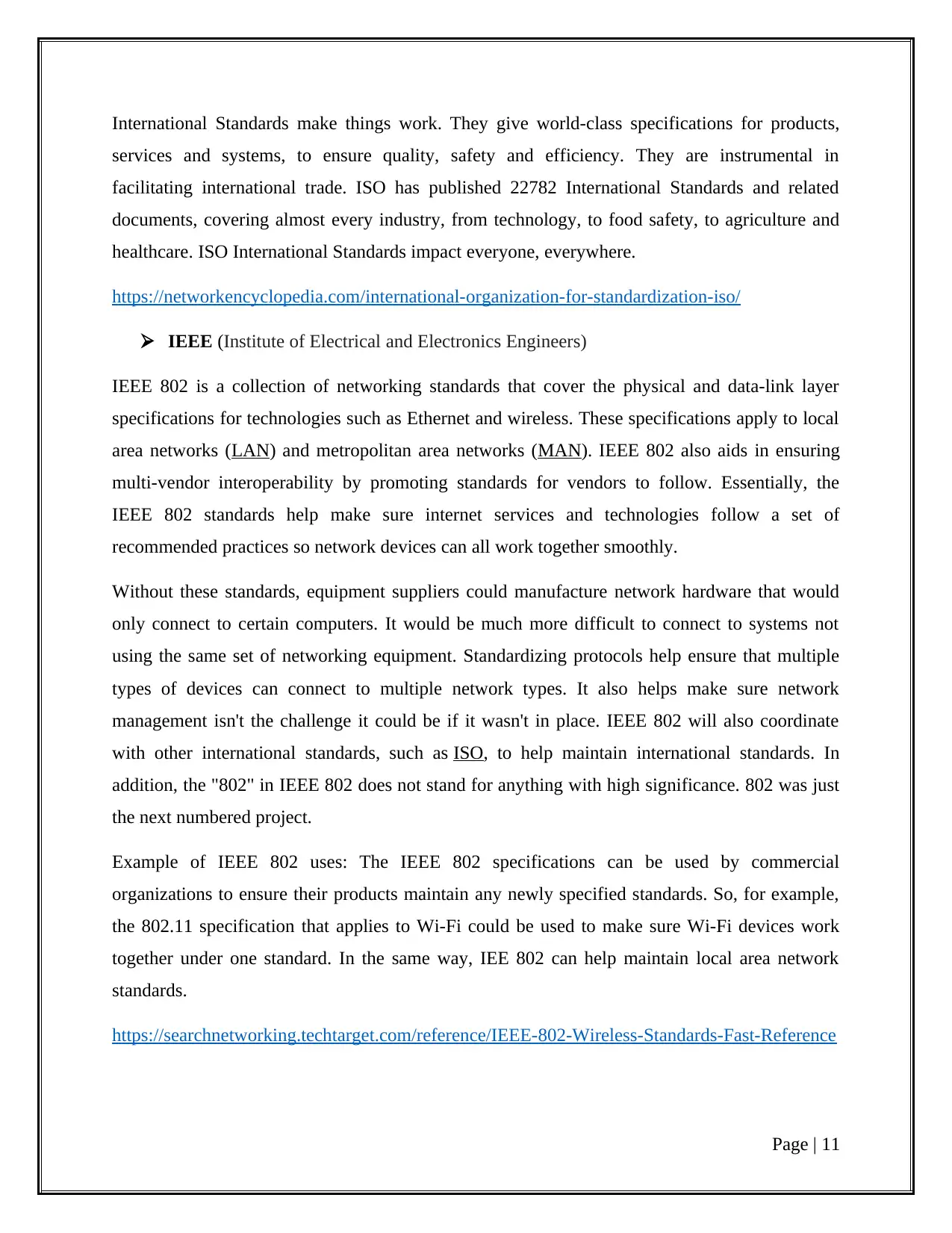
International Standards make things work. They give world-class specifications for products,
services and systems, to ensure quality, safety and efficiency. They are instrumental in
facilitating international trade. ISO has published 22782 International Standards and related
documents, covering almost every industry, from technology, to food safety, to agriculture and
healthcare. ISO International Standards impact everyone, everywhere.
https://networkencyclopedia.com/international-organization-for-standardization-iso/
IEEE (Institute of Electrical and Electronics Engineers)
IEEE 802 is a collection of networking standards that cover the physical and data-link layer
specifications for technologies such as Ethernet and wireless. These specifications apply to local
area networks (LAN) and metropolitan area networks (MAN). IEEE 802 also aids in ensuring
multi-vendor interoperability by promoting standards for vendors to follow. Essentially, the
IEEE 802 standards help make sure internet services and technologies follow a set of
recommended practices so network devices can all work together smoothly.
Without these standards, equipment suppliers could manufacture network hardware that would
only connect to certain computers. It would be much more difficult to connect to systems not
using the same set of networking equipment. Standardizing protocols help ensure that multiple
types of devices can connect to multiple network types. It also helps make sure network
management isn't the challenge it could be if it wasn't in place. IEEE 802 will also coordinate
with other international standards, such as ISO, to help maintain international standards. In
addition, the "802" in IEEE 802 does not stand for anything with high significance. 802 was just
the next numbered project.
Example of IEEE 802 uses: The IEEE 802 specifications can be used by commercial
organizations to ensure their products maintain any newly specified standards. So, for example,
the 802.11 specification that applies to Wi-Fi could be used to make sure Wi-Fi devices work
together under one standard. In the same way, IEE 802 can help maintain local area network
standards.
https://searchnetworking.techtarget.com/reference/IEEE-802-Wireless-Standards-Fast-Reference
Page | 11
services and systems, to ensure quality, safety and efficiency. They are instrumental in
facilitating international trade. ISO has published 22782 International Standards and related
documents, covering almost every industry, from technology, to food safety, to agriculture and
healthcare. ISO International Standards impact everyone, everywhere.
https://networkencyclopedia.com/international-organization-for-standardization-iso/
IEEE (Institute of Electrical and Electronics Engineers)
IEEE 802 is a collection of networking standards that cover the physical and data-link layer
specifications for technologies such as Ethernet and wireless. These specifications apply to local
area networks (LAN) and metropolitan area networks (MAN). IEEE 802 also aids in ensuring
multi-vendor interoperability by promoting standards for vendors to follow. Essentially, the
IEEE 802 standards help make sure internet services and technologies follow a set of
recommended practices so network devices can all work together smoothly.
Without these standards, equipment suppliers could manufacture network hardware that would
only connect to certain computers. It would be much more difficult to connect to systems not
using the same set of networking equipment. Standardizing protocols help ensure that multiple
types of devices can connect to multiple network types. It also helps make sure network
management isn't the challenge it could be if it wasn't in place. IEEE 802 will also coordinate
with other international standards, such as ISO, to help maintain international standards. In
addition, the "802" in IEEE 802 does not stand for anything with high significance. 802 was just
the next numbered project.
Example of IEEE 802 uses: The IEEE 802 specifications can be used by commercial
organizations to ensure their products maintain any newly specified standards. So, for example,
the 802.11 specification that applies to Wi-Fi could be used to make sure Wi-Fi devices work
together under one standard. In the same way, IEE 802 can help maintain local area network
standards.
https://searchnetworking.techtarget.com/reference/IEEE-802-Wireless-Standards-Fast-Reference
Page | 11

OSI
To understand the nuances of network protocols, it's imperative to know about the Open Systems
Interconnection (OSI) model first. Considered the primary architectural model for internet
working communications, the majority of network protocols used today are structurally based on
the OSI model.
The OSI model splits the communication process between two network devices into 7 layers. A
task or group of tasks is assigned to each of these 7 layers. All the layers are self-contained, and
the tasks assigned to them can be executed independently.
Page | 12
To understand the nuances of network protocols, it's imperative to know about the Open Systems
Interconnection (OSI) model first. Considered the primary architectural model for internet
working communications, the majority of network protocols used today are structurally based on
the OSI model.
The OSI model splits the communication process between two network devices into 7 layers. A
task or group of tasks is assigned to each of these 7 layers. All the layers are self-contained, and
the tasks assigned to them can be executed independently.
Page | 12
⊘ This is a preview!⊘
Do you want full access?
Subscribe today to unlock all pages.

Trusted by 1+ million students worldwide
1 out of 21
Your All-in-One AI-Powered Toolkit for Academic Success.
+13062052269
info@desklib.com
Available 24*7 on WhatsApp / Email
![[object Object]](/_next/static/media/star-bottom.7253800d.svg)
Unlock your academic potential
Copyright © 2020–2025 A2Z Services. All Rights Reserved. Developed and managed by ZUCOL.